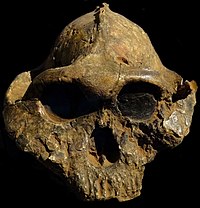Paranthropus
|
Paranthropus "robust australopithecines" Temporal range: Pliocene-, 2.7–1.2 Ma |
|
|---|---|
 |
|
| Skull of Paranthropus boisei | |
| Scientific classification | |
| Kingdom: | Animalia |
| Phylum: | Chordata |
| Class: | Mammalia |
| Order: | Primates |
| Family: | Hominidae |
| Subfamily: | Homininae |
| Tribe: | Hominini |
| Subtribe: | Australopithecina |
| Genus: |
Paranthropus Broom, 1938 |
| Species | |
|
†Paranthropus aethiopicus |
|
†Paranthropus aethiopicus
†Paranthropus boisei
†Paranthropus robustus
Paranthropus (from Greek παρα, para "beside"; άνθρωπος, ánthropos "human") is a genus of extinct hominins. Also known as robust australopithecines, they were bipedal hominids that probably descended from the gracile australopithecine hominids (Australopithecus) 2.7 million years ago. Members of this genus are characterised by robust craniodental anatomy, including gorilla-like sagittal cranial crests, which suggest strong muscles of mastication, and broad, grinding herbivorous teeth. However, Paranthropus skulls lack the transverse cranial crests that are also present in modern gorillas.
A partial cranium and mandible of Paranthropus robustus was discovered in 1938 by a schoolboy, Gert Terblanche, at Kromdraai B (70 km south west of Pretoria) in South Africa. It was described as a new genus and species by Robert Broom of the Transvaal Museum. The site has been excavated since 1993 by Francis Thackeray of the Transvaal Museum. A date of at least 1.95 million years has been obtained for Kromdraai B.
Paranthropus boisei was discovered by Mary Leakey on July 17, 1959, at the FLK Bed I site of Olduvai Gorge in Tanzania (specimen OH 5). Mary was working alone, as Louis Leakey was ill in camp. She rushed back to camp and, at the news, Louis made a remarkable recovery. They refrained from excavating until Des Bartlett had photographed the site.
...
Wikipedia
